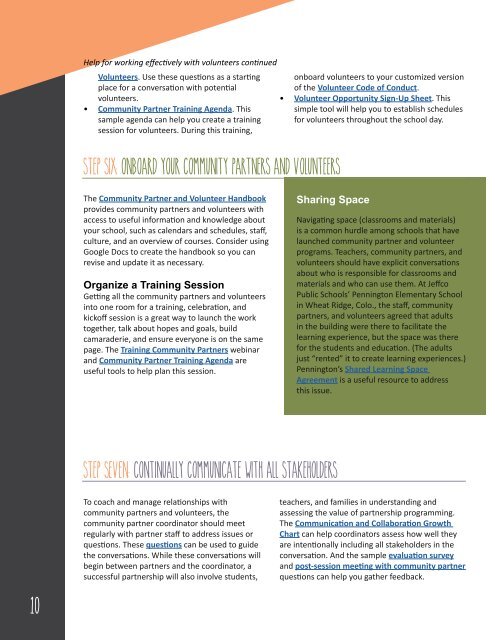DESIGNING COMMUNITY PARTNERSHIPS TO EXPAND STUDENT LEARNING A TOOLKIT
1i4Jz2x
1i4Jz2x
Create successful ePaper yourself
Turn your PDF publications into a flip-book with our unique Google optimized e-Paper software.
Help for working effectively with volunteers continued<br />
Volunteers. Use these questions as a starting<br />
place for a conversation with potential<br />
volunteers.<br />
• Community Partner Training Agenda. This<br />
sample agenda can help you create a training<br />
session for volunteers. During this training,<br />
onboard volunteers to your customized version<br />
of the Volunteer Code of Conduct.<br />
• Volunteer Opportunity Sign-Up Sheet. This<br />
simple tool will help you to establish schedules<br />
for volunteers throughout the school day.<br />
STEP SIX: ONBOARD YOUR <strong>COMMUNITY</strong> PARTNERS AND VOLUNTEERS<br />
The Community Partner and Volunteer Handbook<br />
provides community partners and volunteers with<br />
access to useful information and knowledge about<br />
your school, such as calendars and schedules, staff,<br />
culture, and an overview of courses. Consider using<br />
Google Docs to create the handbook so you can<br />
revise and update it as necessary.<br />
Organize a Training Session<br />
Getting all the community partners and volunteers<br />
into one room for a training, celebration, and<br />
kickoff session is a great way to launch the work<br />
together, talk about hopes and goals, build<br />
camaraderie, and ensure everyone is on the same<br />
page. The Training Community Partners webinar<br />
and Community Partner Training Agenda are<br />
useful tools to help plan this session.<br />
Sharing Space<br />
Navigating space (classrooms and materials)<br />
is a common hurdle among schools that have<br />
launched community partner and volunteer<br />
programs. Teachers, community partners, and<br />
volunteers should have explicit conversations<br />
about who is responsible for classrooms and<br />
materials and who can use them. At Jeffco<br />
Public Schools’ Pennington Elementary School<br />
in Wheat Ridge, Colo., the staff, community<br />
partners, and volunteers agreed that adults<br />
in the building were there to facilitate the<br />
learning experience, but the space was there<br />
for the students and education. (The adults<br />
just “rented” it to create learning experiences.)<br />
Pennington’s Shared Learning Space<br />
Agreement is a useful resource to address<br />
this issue.<br />
STEP SEVEN: CONTINUALLY COMMUNICATE WITH ALL STAKEHOLDERS<br />
To coach and manage relationships with<br />
community partners and volunteers, the<br />
community partner coordinator should meet<br />
regularly with partner staff to address issues or<br />
questions. These questions can be used to guide<br />
the conversations. While these conversations will<br />
begin between partners and the coordinator, a<br />
successful partnership will also involve students,<br />
teachers, and families in understanding and<br />
assessing the value of partnership programming.<br />
The Communication and Collaboration Growth<br />
Chart can help coordinators assess how well they<br />
are intentionally including all stakeholders in the<br />
conversation. And the sample evaluation survey<br />
and post-session meeting with community partner<br />
questions can help you gather feedback.<br />
10


